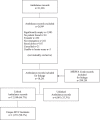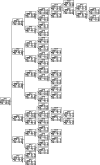A predictive ambulance dispatch algorithm to the scene of a motor vehicle crash: the search for optimal over and under triage rates
- PMID: 35524169
- PMCID: PMC9074212
- DOI: 10.1186/s12873-022-00609-5
A predictive ambulance dispatch algorithm to the scene of a motor vehicle crash: the search for optimal over and under triage rates
Abstract
Background: Calls for emergency medical assistance at the scene of a motor vehicle crash (MVC) substantially contribute to the demand on ambulance services. Triage by emergency medical dispatch systems is therefore important, to ensure the right care is provided to the right patient, in the right amount of time. A lights and sirens (L&S) response is the highest priority ambulance response, also known as a priority one or hot response. In this context, over triage is defined as dispatching an ambulance with lights and sirens (L&S) to a low acuity MVC and under triage is not dispatching an ambulance with L&S to those who require urgent medical care. We explored the potential for crash characteristics to be used during emergency ambulance calls to identify those MVCs that required a L&S response.
Methods: We conducted a retrospective cohort study using ambulance and police data from 2014 to 2016. The predictor variables were crash characteristics (e.g. road surface), and Medical Priority Dispatch System (MPDS) dispatch codes. The outcome variable was the need for a L&S ambulance response. A Chi-square Automatic Interaction Detector technique was used to develop decision trees, with over/under triage rates determined for each tree. The model with an under/over triage rate closest to that prescribed by the American College of Surgeons Committee on Trauma (ACS COT) will be deemed to be the best model (under triage rate of ≤ 5% and over triage rate of between 25-35%.
Results: The decision tree with a 2.7% under triage rate was closest to that specified by the ACS COT, had as predictors-MPDS codes, trapped, vulnerable road user, anyone aged 75 + , day of the week, single versus multiple vehicles, airbag deployment, atmosphere, surface, lighting and accident type. This model had an over triage rate of 84.8%.
Conclusions: We were able to derive a model with a reasonable under triage rate, however this model also had a high over triage rate. Individual EMS may apply the findings here to their own jurisdictions when dispatching to the scene of a MVC.
Keywords: Ambulance; Dispatch; Lights; Motor vehicle crash; Sirens.
© 2022. The Author(s).
Conflict of interest statement
EB, DB, PB, RB and AW are employed by St John Western Australia (SJ-WA). JF and SB hold adjunct research positions at SJ-WA. JF receives research funding from SJ-WA.
Figures



References
-
- Watanabe BL, Patterson GS, Kempema JM, Magallanes O, Brown LH. s Use of Warning Lights and Sirens Associated With Increased Risk of Ambulance Crashes? A Contemporary Analysis Using National EMS Information System (NEMSIS) Data. Ann Emerg Med . 2019;74:101–9. doi: 10.1016/j.annemergmed.2018.09.032. - DOI - PubMed
-
- Clawson J, Dernocoeur KB, Murray C. Protocol 29: Traffic/Transportation Incident. Princ Emerg Med Dispatch. 5th ed. Salt Lake City: International Academy of Emergency Medical Dispatch; 2014.
Publication types
MeSH terms
LinkOut - more resources
Full Text Sources
Medical
Miscellaneous

